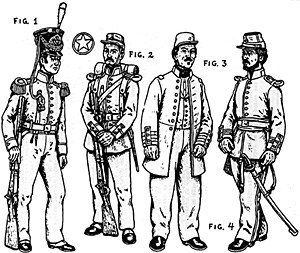Imperial Brazilian Uniforms
During the
War of the Triple Alliance
Part 1: Line Infantry
By C. A. Norman
| |
FUSILIEROS:
Fig. 1. Fusilier, 1st Battalion, Summer Full Dress, c.1865: Black shako with brass "rayed" front plate (incorporating the battalion number), above this the national cocade - a yellow 5-point star on a green field with narrow yellow outer edging (detail figure to right), white cords and flounders, and a tallish red plume tipped white. Dark blue coatee with white collar and turnbacks, and yellow round cuffs, all edged with red piping including the front opening and pocket flaps on the tails, brass buttons. On the shoulders epaulets with red straps and pads, the former edged with white piping, smooth brass crescents and white fringe. White trousers, gaiters, gloves, waistbelt and musket strap. Clearly visible here is one of the more unusual distinctions of the period: a white leather strap attached to a button on the right breast, the lower ends carrying a needle and small brush for clearing the muskets touchhole; normally the lower end would be tucked under the waistbelt {as here) to keep it from entangling the man's arms or equipment, in battle it might be left hanging free for ready use. Fig.2. Fusilier, 1st Battalion, "Second" or Service Uniform, c.1865: The kepi has a dark blue top and white (battalion colour) band, both piped with red, white leather chinstrap, small national cocade on the front. Dark blue tunic with red front piping, brass buttons. On this garment the white collar colour is reduced to a smallish patch on either side of the collar, piped with red on 3 sides, and the yellow cuff colour is reduced to a 3 button flap (also piped with red) on the outer side of the cuff, the collar and cuffs themselves being dark blue with red piping along the top. With this garment the fringed full dress epaulets are replaced by soft dark blue straps piped red, the outer ends carrying large white woolen crescents rather similar to those used by British centre company troops during the 1830-40's. White trousers and gaiters. The white waistbelt equipment was patterned on the French model, with 3-part shoulder straps supporting the pack with dark blue greatcoat roll strapped on the top. A small black pouch is visible on the front of the waistbelt to the right of the brass plate; presumably a percussion cap pouch. Fig.3. Colonel, Undress Uniform, c.1866-70: Kepi in a white cotton cover. The long dark blue tunic is a privately acquired non-regulation type, almost a frock-coat, with red rectangular collar patches (no collar piping), red piping down the front opening and edging the dark blue cuff flaps, gilt buttons and 3 wide gold rank laces circling the cuff, plain dark blue epaulet holding straps on the shoulders. White cotton or linen trousers and waistcoat, white shirt, a black scarf wrapped around the neck in place of a stock. Fig.4. Lieutenant, Service Dress, 1866 Uniform: Dark blue kepi with red band and vertical piping on front, side and rear seams, national cocade on the front, white leather strap, black peak. Dark blue tunic with red collar patches and red piping edging the top of the collar, front opening, dark blue cuffs and cuff flaps, and rear pocket flaps, gilt buttons and 2 narrow gold lace rank stripes circling the cuff just below the red piping. For more "dressy" occasions stiffened dark blue shoulder straps were worn with gilt metal crescents and red piping edging the straps, Dark blue trousers with red piping down outer seams. A white waistbelt is worn over the darkish red or crimson waist-sash, white sabre knot. This is the "regulation" 1866 uniform, worn in the authorised manner. The dark blue base colour was very dark, more or less a "blue-black". Rank insignia conformed to the dress regulations of 1852, following the system:
Lieutenant (Tenente): 2 narrow lace stripes. Captain (Capitao): 1 broad lace stripe. Major (Major): 1 broad stripe with a narrow stripe below. Lieut. Colonel (Tenente Coronel): 2 broad stripes. Colonel (Coronel): 3 broad stripes. Normally these were to be worn in the following manner: ranks from Ensign to Captain were to wear their rank stripes on the cuff, below the cuff piping. Majors and Lieutenant Colonels were to wear the top lace stripe above the cuff piping and the bottom one below the piping. Colonels rank lace almost covered the cuff and were normally worn with the centre lace covering the cuff piping. However there seems to have been a good deal of variation in this, many officers suiting themselves in this regard. Some officers also wore a second set of rank laces circling the kepi band, though this was not authorized by regulations. Illustrations
Figures 5 - 7: Two Fusiliers, Capt. Figures 8 - 11: Two Cacadores, Col., Ensign Figures 12 -14: Three Cacadores on campaign Back to Brazilian Uniforms Part 1 Back to Table of Contents -- El Dorado Vol VII No. 1 © Copyright 1996 by The South and Central Military Historians Society This article appears in MagWeb (Magazine Web) on the Internet World Wide Web. |